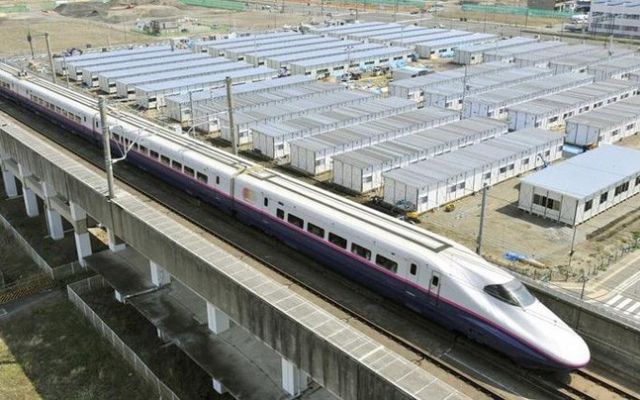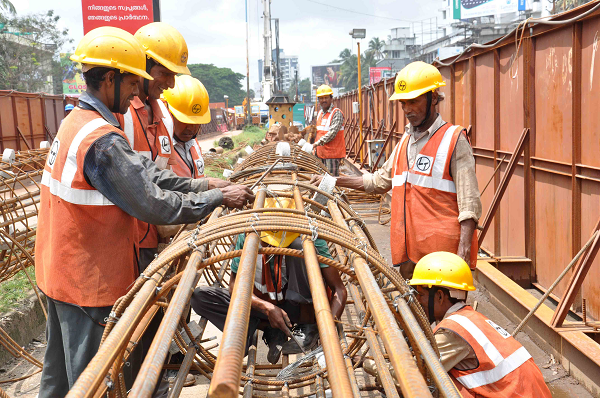
by admin | May 25, 2021 | Business, Economy, Large Enterprise, Markets, Medium Enterprise, News, SMEs
 (Note Ban Series)
(Note Ban Series)
By Nishant Arora,
New Delhi : The first three quarters of 2016 were going just great and smartphone players had raked in super profits right up to Diwali — then demonetisation caught them by surprise, as it did others.
The note ban hit manufacturers across the spectrum — especially domestic handset makers who primarily rely on cash sales in smaller cities and towns.
The subsequent cash crunch resulted in smartphone sales falling by 30.5 per cent (month-on-month) in November over the October festive season.
According to global market research firm International Data Corporation (IDC), Indian vendors were affected the most — with a drop of 37.2 per cent in November — as compared to Chinese players with a 26.5 per cent drop and global vendors with 30.5 per cent drop over the previous month.
When contacted by IANS, Indian vendors Micromax and Intex declined to comment.
“Demonetisation impacted the smartphone market at almost all levels, including the customer demand and stock movement in the distribution channels,” said Upasana Joshi, Senior Market Analyst, IDC India.
In the fourth quarter (Q4) of 2016, smartphone shipments clocked 25.8 million units — registering similar volume as that of 2015 but declining sharply by 20.3 per cent over the previous quarter owing to demonetisation, which led to relatively lower consumer sales in November and December.
According to the data provided by CyberMedia Research (CMR) to IANS, the smartphone shipment to India was 10 million units in October last year which shrank to 9.2 million units in November and then, slightly improved to 9.6 million units in December.
The slowdown was seen across all cities. There was a huge drop in inquiries and significantly reduced footfall at retail shops. To counter this, handset retailers started offering zero down payment options to improve sales.
To overcome the impact, smartphone players with huge online presence started offering EMI and easy payment options to keep the sales going.
Amid all this, China-based vendors’ market share improved sequentially owing to their high decibel marketing, increased credit line to distributors and efficient channel management.
The sales, however, picked up in 2017 and smartphone players heaved a sign of relief as the cash flow got better.
“In the first quarter of this year, the smartphone shipment was 26.5 million units while in the second quarter, it was 28.4 million units,” Prabhu Ram, General Manager, Industry Intelligence Group (IIG) at CMR, told IANS.
Local brands like Micromax and Lava grew 41 per cent and 24 per cent (QoQ) in the smartphone segment in the third quarter this year, respectively, recovering from their all-time low during demonetisation last year.
Global vendors, led by Samsung, were able to withstand the aggressive Chinese players post-demonetisation owing to their good distributor coverage and penetration in the Indian market.
“The overall industry sentiments were pulled down after note ban, having an impact on smartphones as well. People had tightened their fists and spending was at its lowest ebb,” Faisal Kawoosa, Principal Analyst, Telecom and ESDM, CyberMedia Research (CMR), told IANS.
The industry proactively adjusted the smartphone shipment, scaled down advertising and marketing to the lowest possible levels and resorted to a “wait and watch” policy.
“As soon as the market momentum regained, they flooded the market with new offerings, advertising, marketing as well as promotions that synced up very well with the festive season. And thus we saw a strong comeback,” Kawoosa added.
But the impact of demonetisation will be felt when 2017 comes to a close.
According to the market research firm Gartner, there will be a two per cent drop in the Indian government’s IT spending this year owing to demonetisation and a drop in industrial production.
The government is forecast to spend $7.8 billion on IT in 2017 — a 7.5 percent increase from 2016. This is, however, down from Gartner’s projection of 9.5 percent growth this year.
“The two percent revision in our outlook is primarily due to the effects of demonetisation and a drop in industrial production,” Moutusi Sau, principal research analyst at Gartner, said in a statement recently.
(Nishant Arora can be contacted at nishant.a@ians.in)
—IANS

by admin | May 25, 2021 | News, Politics
 Mumbai : As the Narendra Modi government proceeds with the grandiose plans for a Bullet Train between Mumbai and Ahmedabad, a RTI query has revealed that over 40 percent of seats on all the trains on this sector go vacant causing huge losses to Western Railway.
Mumbai : As the Narendra Modi government proceeds with the grandiose plans for a Bullet Train between Mumbai and Ahmedabad, a RTI query has revealed that over 40 percent of seats on all the trains on this sector go vacant causing huge losses to Western Railway.
According to RTI replies received by Mumbai activist Anil Galgali, only in the past one quarter, the Western Railway’s staggering losses on this sector is nearly Rs 30 crore, or around Rs. 10 crore per month.
“The Indian government is over-enthusiastic and plans to spend more than Rs 1 lakh crore on the Bullet Train project, but it has not done its homework properly,” Galgali said, adding it raises serious question marks on the viability of the Bullet Train project, whenever it comes up.
The Indian Railways have also admitted that they have no plans to introduce any new trains on this sector which is already in the red.
Replying to Galgali’s query on seats occupancy on all the trains between the two cities, the WR revealed that in the past three months, 40 percent all seats went vacant on the Mumbai-Ahmedabad sector and 44 percent empty on the Ahmedabad-Mumbai route.
WR’s Chief Commercial Manager Manjeet Singh said that between July 1-September 30, there are 32 mail/express serving this sector with a total seating capacity of 735,630 seats on the Mumbai-Ahmedabad sector.
Of these, only 441,795 seats were booked during that period generating a revenue of Rs 30,16,24,623 against the total estimated expected income of Rs 44,29,08,220 – incurring a huge loss of Rs 14,12,83,597 in the past quarter.
Similarly, on the Ahmedabad-Mumbai route served by a total of 31 mail/express trains with a seating capacity of 706,446, only 398,002 seats were booked, resulting in a revenue of Rs 26,74,56,982 against the estimated expected income of Rs 42,53,11,471, spelling a massive loss of Rs 15,78,54,489.
The WR provided the data of all the major trains plying on the Mumbai-Ahmedabad-Mumbai route like the Durantos, Shatabdi Expresses, Lokshakti Express, Gujarat Mail, Bhavnagar Express, Saurashtra Express, Vivek-Bhuj Express and others.
Faced with the vacancies on existing trains, the WR Divisional Engineer, Ahmedabad informed that there is no fresh proposal to introduce any new trains on this sector.
In fact, Galgali said that the most popular train, 12009 Shatabdi Express with a capacity of 72,696 seats sold only 36,117 during the July-September period on the Mumbai-Ahmedabad route and in the return direction of the total 67,392 seats, only 22,982 were sold.
This train, which once always ran packed in all seasons both ways has now proved to be a loss-maker, and the executive chair car with 7,505 seats was practically deserted with just 1,469 seats booked, plummeting revenues from the estimated Rs 1,45,49,714 to a paltry Rs 26,41,083 during the last quarter.
The position in all other trains was similar and though there is a higher demand for sleeper class compared to seats, the WR has not done enough to augment its capacity.
Galgali pointed out that given this current alarming scenario, coupled with growing preference for flights and improved road travel, the Central and Gujarat governments must review the expensive option of the Bullet Train before it becomes a white elephant for the Indian taxpayers.
—IANS

by admin | May 25, 2021 | Banking, Business, Corporate, Corporate Governance, Economy, Finance, Markets, Medium Enterprise, News, Politics, SMEs
 (Note Ban Series)
(Note Ban Series)
By Nivedita,
New Delhi : Style, it would appear, never goes out of fashion. But the passion to spend on designer clothes and accessories took a beating in the past year, ever since the Narendra Modi government implemented the demonetisation policy. The introduction of the Goods and Services Tax (GST) in July added to the woes, say designers.
“Demonetisation was a wonderful move by the government, but it was badly executed. They did not see the entire scenario. It has disrupted the business (of fashion). There were a lot of times that my employees — like tailors and embroiderers — could not go to the bank. Demonetisation impacted them badly,” Rahul Mishra, a regular participating designer at the Paris runways, told IANS.
The stress, he says, was felt more by weavers, embroiderers, tailors and craftspersons. The introduction of GST on July 1 impacted the same set of people more than others.
“I am not against GST. We work with handmade clothes and labour is intensive. So if I supply merchandise worth Rs 1 crore, then 12 per cent needs to be paid upfront as GST. Next month, again if I am supplying, then I have to pay 12 per cent, so I have to pay so much to GST and then wait for the sale to happen.”
He says the government should encourage the handmade industry by bringing in separate laws for it. “I want to pay taxes on what I am selling because if I am not selling, then business is less, opportunity is less and so is potential for employment,” said Mishra.
A report by Investment Information and Credit Rating Agency of India (ICRA) stated that the Indian textiles and apparel industry, which accounts for almost 24 per cent of the world’s spindle capacity and eight per cent of global rotor capacity, has been struggling due to the impact of demonetisation and GST.
The report stated that the disruptions caused by demonetisation and transition to the GST regime has “narcotised the Indian apparel and fabric industry”.
Other designers say they are witnessing reduced business, but they are hopeful that the forthcoming wedding season may bring a touch of relief. Many feel that banning of Rs 500 and Rs 1,000 currency notes was a good move to weed out corruption in the country, even though it took its toll on the design world. GST only added to their troubles.
Designer Samant Chauhan is disappointed that the festive season failed to raise the shoppers’ spirit.
“I always knew that the market is slow and we will get good sales in Diwali. But things were not that great during the festive time either, with sales at less than half. There was no (big) party happening on Diwali, so why will people buy designer clothes. I think the note ban did have an impact on that (party culture).
He said that after demonetisation, prices of yarns and fabric went up. “Only those people survived who had systems (workstations and mills). There was a huge crunch of fabric as most of the weavers were in the bank getting their cash. When things normalised, the prices went up,” he added.
Sunil Sethi, President, Fashion Design Council of India (FDCI), the country’s apex fashion body, admitted that sales had slumped due to demonetisation and GST.
“I’m hoping that the business is going to be regularised in the near future. Certain amount of discipline has set in for both the customer and designer. However, there is no doubt that the volume of business has gone down, which is not a good sign. Hoping for the market to pick up soon,” Sethi told IANS.
Menswear designer Pawan Sachdeva echoed the sentiment. “The effect of demonetisation has lingered even after a year. The luxury market has faced a major slowdown. Even as the effects of demonetisation hadn’t lessened, GST was introduced as a new policy, slowing the market even more,” he said.
The major problem, according to him, was that cash flow declined sharply, resulting in slashing of up to almost 80 per cent of luxury sales. “This Diwali, the sales were extremely low as compared to previous years. It will take a lot of time for the market to recover at this rate,” Sachdeva said.
(Nivedita can be contacted at nivedita.s@ians.in)
—IANS

by admin | May 25, 2021 | Employment, Opinions
 By Amit Kapoor,
By Amit Kapoor,
The lack of jobs is beginning to haunt the Modi government. The Reserve Bank of India’s recent Consumer Confidence Survey shows that public perception is also beginning to take account of the fact that there are no jobs available in the economy. According to the survey, 43.7 percent of responders felt that the employment situation had worsened as compared to 31.9 percent a year ago.
The official unemployment numbers, which hover at around five per cent, will never reflect the true picture since in a developing economy, where poverty is high and unemployment benefits are virtually non-existent, no one can afford to remain out of the workforce for long. They usually find employment doing odd jobs or in the agricultural sector.
However, job creation numbers do give a clearer picture. According to the Labour Bureau, the Indian economy was generating around 900,000 jobs in 2010 and 2011. Since then, the jobs created in the economy have consistently fallen, reaching around 135,000 in 2015 as opposed to the need for an annual generation of over 11,00,000 jobs. The situation has not improved since.
However, this is not a recent phenomenon. The Indian economy has never been good at creating jobs. As per popular estimates, including those of the RBI, India’s employment elasticity, which is a measure of the percentage in employment for a one percent change in economic growth, has been around 0.2 in the post-reform period. This implies that as the real GDP rises by 10 percent, employment will merely rise by two percent. To put things in perspective, International Labour Organisation (ILO ) estimates Brazil’s employment elasticity to be an impressive 0.9.
This long-term trend shows that there is a structural reason behind this problem. When an economy transitions from agricultural-led to a modern one, it undergoes three key transformations: Movement of labour out of agriculture into industry and then services, shift of workers from informal into the formal sector and finally a rapid pace of urbanisation as more industries are set up in the rural areas around cities.
India has missed the bus on all three of these fronts. Industrial development never took place in India and the economy became service-led right away. Employment in industry and services remains predominantly informal. Consequently, the pace of urbanisation has slowed in India.
Moreover, whatever industrial development has taken place in India has been either capital-intensive or skilled labour-intensive. India’s labour-capital ratio in a vast majority of industries has been lower than other countries at similar levels of development. The very opposite is needed for job creation in a developing economy. But why has the pace of development been so skewed for India? What is so different about India that made it deviate from the historical trend of structural transformation for economies around the world?
India’s notoriously rigid labour laws are the leading cause behind these anomalies. Labour falls under the concurrent list of the constitution, which implies that both the Centre and the states can form laws on it and neither has been miserly about this. When combined, each state ends up with over 200 different labour laws. These disincentivise firms from growing beyond a point. For instance, the Trade Unions Act of 1926 requires firms with seven or more workers to form trade unions. The Factories Act of 1948 mandates manufacturing units with 10 or more workers to have several working hour limits and work place conditionalities that become stricter with more workers.
The most burdensome of all is the Industrial Disputes Act (IDA) of 1947, which covers all industrial disputes and makes it almost impossible for firms with 100 or more workers to fire anyone. Establishments require permission from the labour department to lay anyone off and such permissions are rarely given even if the firm is unprofitable. Therefore, firms with six or less employees have the most labour flexibility.
As expansion of firms comes with high legislative costs in India, it is rational for them to remain small. This is why 84 per cent of manufacturing employment is restricted to micro and small enterprises in stark contrast with other developing countries (46 per cent for South Korea and Thailand, 27 per cent for Malaysia and 25 per cent for China).
India’s labour laws have inhibited the growth of manufacturing firms, which lose out on the gains they could have made from economies of scale and innovation. Due to these reasons India has not been able to undergo industrial development and is finding it difficult to gain from the rise in labour costs in China. India could have been the next manufacturing hub after China but since there is a sheer lack of capability; countries like Bangladesh and Vietnam have been thriving in labour-intensive sectors like textiles.
Labour reforms are, therefore, the antidote to India’s perpetual job crisis — but this is politically sensitive topic. The Modi government is in a unique position of being capable enough of pushing through such bold reforms since it has the numbers needed for this. However, considering how most of its attempts at reform have backfired, this will be the farthest thing on the government’s mind. A piecemeal attempt at labour reform with the Small Factories Bill, which aims to exempt factories with 40 workers from 14 labour laws, has been in limbo for the last two years.
However, on a positive note, some state governments are beginning to allow larger firms to retrench workers without seeking permission with their own amendments to IDA. Hopefully, it will not be too late before India manages to extricate itself from this mess of its own creation.
(Amit Kapoor is chair, Institute for Competitiveness, India. The views expressed are personal. He can be contacted at amit.kapoor@competitiveness.in. Chirag Yadav, senior researcher, Institute for Competitiveness, India has contributed to the article.)
—IANS

by admin | May 25, 2021 | Opinions
 By Amit Kapoor,
By Amit Kapoor,
In a respite to the Modi government, which has been facing the heat over dismal economic numbers, the World Economic Forum (WEF) study on global competitiveness for 2017 commended the improving quality of institutions in India, especially in terms of improved efficiency of public spending in the last few years. This was despite the fact that India slipped a place to rank 40 out of a total 137 countries in the Global Competitiveness Index 2017-18.
However, the WEF has clarified that it has changed its methodology this year and the rankings are not comparable with those of last year. Moreover, it also pointed out that this is India’s highest score ever with the new methodology (4.6 compared to 4.5 in the previous year). The country’s score has improved across most indicators of competitiveness, especially infrastructure (66th, an improvement of two points over last year), higher education and training (75th, up six) and technological readiness (107, up two), which is a reflection of recent public investment in these areas.
India has also ranked the highest among all South Asian countries with the next highest being Bhutan and Sri Lanka ranked at 85. Among the BRICS nations, China (27) and Russia (38) rank above India while South Africa and Brazil are placed at 61 and 80. In a major hopeful boost to the dwindling India growth story, the report stated that among the emerging markets that were seen to have great potential in the early 2000s, Brazil and Turkey have lost much of what they had gained before 2013, while China, India and Indonesia continue to grow strong.
The report also gives some useful insights about the growth trends of the Indian economy. First, among the emerging economies, it finds that India and China are gradually developing into major centres of innovation. In a recent study of geographical clusters generating the most patents, three Indian cities appeared in the top 100 with Bengaluru at 43 (with patent activity focused on computer technology), Mumbai at 95 and Pune at 96 (with both registering among the most patents in organic chemistry). Due to such an improvement in the innovative environment within India, the WEF rankings place India at 29 on the innovation pillar for competitiveness.
Since innovation is a major determinant of the long-term growth trends of an economy, these figures bode well for India’s future prospects. However, the improvement comes with a caveat. It has been seen that emerging economies that are doing well in innovation are leaving large sections of the population behind since they are not technologically equipped.
The level of technological readiness of individuals and firms in countries like India and China are relatively low. This indicates that the innovative space in these countries is not quite inclusive in nature. Along with innovation, it is necessary to ensure that more people and firms have the required means to access and make use of the new technology. India fares poorly on that front. As mentioned, India ranks a lowly 107 in technological readiness. As long as there remains such a disconnect between technological strength and technological readiness, the gains from it cannot be shared across the wider economy and will only lead to an unequal society. So, India urgently needs to act upon technological readiness to make its economy competitive on a larger scale.
The second insight from the Global Competitiveness Index is the performance of the health and primary education pillar, in which India ranks at 91 — second-worst only to technological readiness. It cannot be overstated how poor health and education outcomes can affect the competitiveness of a country and its citizens. India has always had a history of poor public investment in health and primary education and it pays a hefty cost for this in terms of its competitiveness. Such a continued trend in the long run will result in an unequal and mostly unproductive society where only the well-off, who manage to provide nutrition and education for their children, will thrive.
Thirdly, the WEF Executive Opinion Survey reveals that the private sector still considers corruption to be the most problematic factor for doing business in India. This finding puts a question mark over the effectiveness of the government’s attack on corruption over the last few years. Lack of access to financing and tax regulations also remain the prime problems for setting up a business in India. The former might gradually subside when the problems of non-performing assets (NPAs) with banks is remedied, while the latter might change once the economy adjusts to the newly-implemented Goods and Services Tax (GST). However, corruption will continue to remain an impediment to the country’s competitiveness and its long-term growth.
Therefore, India might be improving on the competitiveness index owing to high public investment in some crucial sectors, but large ailments within the economy still remain. Problems of corruption and a gross negligence of health and education sectors have always defined India’s competitiveness. A recent growth in innovative tendencies seemed to be a saving grace but as it turns out, there seem to be distributive issues. How India handles these concerns will determine its future.
(Amit Kapoor is Chair, Institute for Competitiveness, India. The views expressed are personal. He can be contacted at amit.kapoor@competitiveness.in and tweets @kautiliya. Chirag Yadav, researcher, Institute for Competitiveness, India, contributed to the article.)
—IANS





